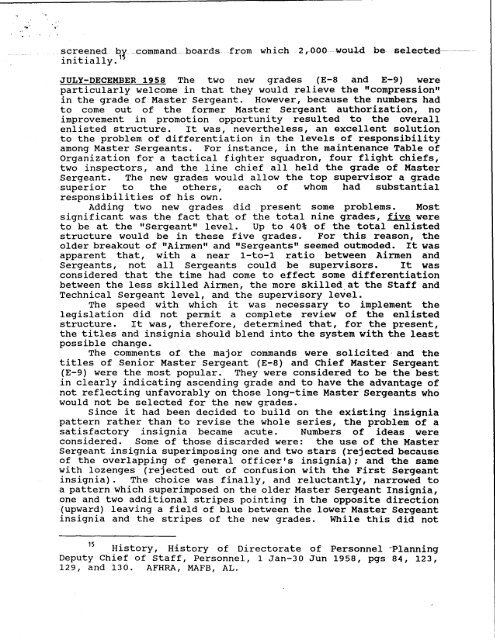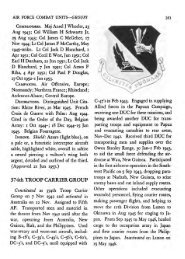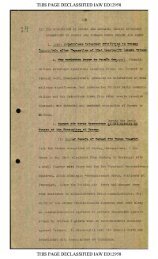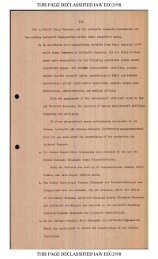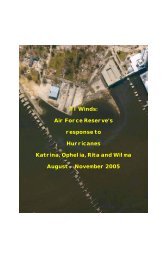A Chronology Of The Enlisted Rank Chevron Of - Air Force Historical ...
A Chronology Of The Enlisted Rank Chevron Of - Air Force Historical ...
A Chronology Of The Enlisted Rank Chevron Of - Air Force Historical ...
Create successful ePaper yourself
Turn your PDF publications into a flip-book with our unique Google optimized e-Paper software.
screened- b r command--- boards- from which - 2,-0-0D---Id -I -be- selected- -<br />
initially .<br />
JULY-DECEMBER 1958 <strong>The</strong> two new grades (E-8 and E-9) were<br />
particularly welcome in that they would relieve the "compression"<br />
in the grade of Master Sergeant . However, because the numbers had<br />
to come out of the former Master Sergeant authorization, no<br />
improvement in promotion opportunity resulted to the overall<br />
enlisted structure . It was, nevertheless, an excellent solution<br />
to the problem of differentiation in the levels of responsibility<br />
among Master Sergeants . For instance, in the maintenance Table of<br />
organization for a tactical fighter squadron, four flight chiefs,<br />
two inspectors, and the line chief all held the grade of Master<br />
Sergeant . <strong>The</strong> new grades would allow the top supervisor a grade<br />
superior to the others, each of whom had substantial<br />
responsibilities of his own .<br />
Adding two new grades did present some problems . Most<br />
significant was the fact that of the total nine grades, five were<br />
to be at the "Sergeant" level . Up to 40% of the total enlisted<br />
structure would be in these five grades . For this reason, the<br />
older breakout of "<strong>Air</strong>men" and "Sergeants" seemed outmoded . It was<br />
apparent that, with a near 1-to-1 ratio between <strong>Air</strong>men and<br />
Sergeants, not all Sergeants could be supervisors . It was<br />
considered that the time had come to effect some differentiation<br />
between the less skilled <strong>Air</strong>men, the more skilled . at the Staff and<br />
Technical Sergeant level, and the supervisory level .<br />
<strong>The</strong> speed with which it was necessary to implement the<br />
legislation did not permit a complete review of the enlisted<br />
structure . It was, therefore, determined that, for the present,<br />
the titles and insignia should blend into the system with the least<br />
possible change .<br />
<strong>The</strong> comments of the major commands were solicited . and the<br />
titles of Senior Master Sergeant (E-8) and Chief Master Sergeant<br />
(E-9) were the most popular . <strong>The</strong>y were considered to be the best<br />
in clearly indicating ascending grade and to have the advantage of<br />
not reflecting unfavorably on those long-time Master Sergeants who<br />
would not be selected for the new grades .<br />
Since it had been decided to build on the existing insignia<br />
pattern rather than to revise the whole series, the problem of a<br />
satisfactory insignia became acute . Numbers of ideas were<br />
considered . Some of those discarded were : the use of the Master<br />
Sergeant insignia superimposing one and two stars (rejected because<br />
of the overlapping of general officer's insignia) ; and the same<br />
with lozenges (rejected out of confusion with the First Sergeant<br />
insignia) . <strong>The</strong> choice was finally, and reluctantly, narrowed to<br />
a pattern which superimposed on the older Master Sergeant Insignia,<br />
one and two additional stripes pointing in the opposite direction<br />
(upward) leaving a field of blue between the lower Master Sergeant<br />
insignia and the stripes of the new grades . While this did not<br />
15<br />
History, History of Directorate of Personnel -Planning<br />
Deputy Chief of Staff, Personnel, 1 Jan-30 Jun 1958, pgs 84, 123,<br />
129, and 130 . AFHRA, MAFB, AL .


